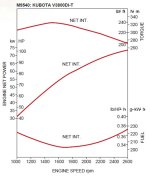what you said true but when you factor in the engines efficiency shown in the attached brake specific fuel consumption which shows the engines in terms of fuel usage you understand why engine RPM not just load also impact the fuel economy and why economy pto's save fuel
example 1
Part 1 1650 RPM
Looking at these curves lets say you need all 70 hp (about the max power that this engine makes at 1650 rpm) this motor uses about .335 lbs of fuel/(hp hour) that translates to 23.45 lbs of fuel per hour.
Part 2 2600 RPM
now lets say your running the engine at WOT 2600 rpm using the same 70 hp load the engine uses about .375 lbs of fuel/(hp hour) totaling 26.25 lbs of fuel
diesel weights roughly 7 lbs a gallon
For Part 2 you would burn 3.75 gallons per hour for Part 1 you would Burn 3.35 gallons per hour or .5 gallons per hour difference In terms of dollars $2 per hour when diesel is $4 a gallon I realize this is a worst case assessment but its only to illustrate why over time an economy PTO saves Farmers money. If your only talking a few hours your right fuel usage is similar. but over hundreds or thousands of hours big money can be saved.
Running the tractor at slow speed does not mean you actually save fuel example
Tho one that people have the hardest time grasping is the fact that faster rpm can mean less fuel usage in the case where you run your tractor at 1700 rpm versus 1000 rpm you will actually use less fuel at 1700 rpm the engines efficiency comes into play here. People automatically assume that if the tractor will do the job as slower RPM they are saving fuel
Example 2 abbreviated
lets say your doing loader work and only run the tractor at 1200 rpm because you think your saving fuel rather than running the tractor at higher RPMs and your hydraulics are reasonably responsive in this range let say your average 30 hp load over the hour your burning about 1.6 gallons assuming about .36 BSFC and again at 1750 rpm your using about .335 bfsc you burn about 1.43 gallons so you spend about $0.70 per hour more running the tractor slower
View attachment 310247


